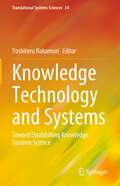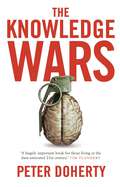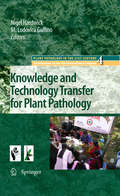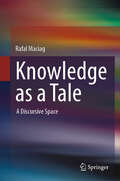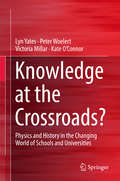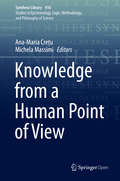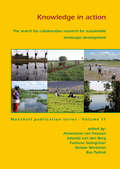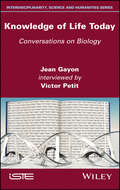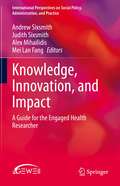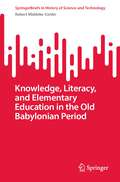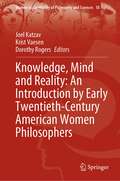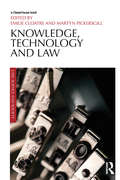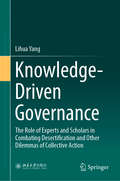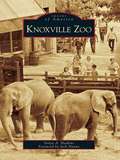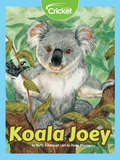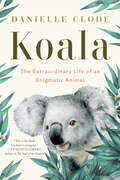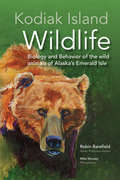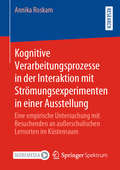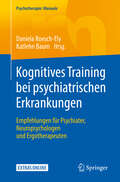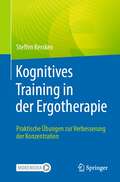- Table View
- List View
Knowledge Technology and Systems: Toward Establishing Knowledge Systems Science (Translational Systems Sciences #34)
by Yoshiteru NakamoriThis book discusses technology and systems to create valuable ideas from data through the construction of knowledge. The primary concern is to make better decisions about economic and management issues in today’s information-flooded society. Human creative activity is in the realm of soft technology, with no physical entity to operate. Focusing on the ability of knowledge as judgment power, this definition results: “Knowledge technology is soft technology that underpins the human creative activities of converting data and information into knowledge, creating new ideas based on that knowledge and validating those ideas.” That definition includes a wide range of soft technologies developed in informatics, management studies, and systems science. The knowledge system creates ideas from data and knowledge through knowledge technologies. Based on the proposition that knowledge emerges by the interaction between explicit and tacit knowledge, another definition is possible: “The knowledge system is a system that promotes interaction between codified and personalized knowledge and creates ideas for solving a specific problem.” Codified knowledge includes data and information, while personalized knowledge is empirical knowledge or wisdom that is difficult to put into words. Building a knowledge system requires mathematical or intelligent knowledge technology and participatory knowledge technology to create or manage codified knowledge and personalized knowledge. For example, a company builds cross-sectional knowledge systems by gathering human resources from various departments, according to the purpose, as in new product development or sales promotion. Chapter 1 defines knowledge technology and the knowledge system and organizes the challenges in their development, while Chapters 2 through 9 introduce mathematical or intelligent knowledge technologies by researchers at the forefront of knowledge technology development.
Knowledge Wars
by Peter DohertyClimate scientists have warned that we need to change our behaviour in ways that may be inconvenient and threaten the commercial status quo. The result has been a polarising division in society and a sustained attack on their research. In The Knowledge Wars, Nobel prizewinner Peter Doherty makes a passionate case for citizens to become informed so they are able to evaluate the facts of any scientific debate. It provides practical advice on how to analyse research and take meaningful action. The Knowledge Wars challenges our assumptions and encourages us to take an evidence-based view of the world. There's something here to offend everybody!
Knowledge and Technology Transfer for Plant Pathology
by Maria Lodovica Gullino Nigel HardwickThis book contains fuller versions of the papers and posters presented in the Knowledge and Technology Transfer and Teaching Plant Pathology sessions at the 9th International Congress of Plant Pathology held in Turin, Italy in 2008. Extension/advisory plant pathology and teaching are about relationships: the relationship between the advisor and grower and the teacher and student. It is about the building up of trust in the advice given and the enthusiasm of, and methods used by, the teacher. Extension plant pathology had been described as 'plant pathology with a human face'. It is aspects of these personal relationships that are explored in this book. Also covered are the value of participation in decision making, plant clinics and teaching approaches, both in industry and at universities. The book is aimed at those who have an interest in providing advice to farmers and growers and in teaching the subject to those who are to provide that advice.
Knowledge and Time
by Harald Atmanspacher Hans PrimasThis is a unique volume by a unique scientist, which combines conceptual, formal, and engineering approaches in a way that is rarely seen. Its core is the relation between ways of learning and knowing on the one hand and different modes of time on the other. Partial Boolean logic and the associated notion of complementarity are used to express this relation, and mathematical tools of fundamental physics are used to formalize it. Along the way many central philosophical problems are touched and addressed, above all the mind-body problem. Completed only shortly before the death of the author, the text has been edited and annotated by the author's close collaborator Harald Atmanspacher.
Knowledge and the Public Interest, 1575–1725
by Vera KellerMany studies relate modern science to modern political and economic thought. Using one shift in order to explain the other, however, has begged the question of modernity's origins. New scientific and political reasoning emerged simultaneously as controversial forms of probabilistic reasoning. Neither could ground the other. They both rejected logical systems in favor of shifting, incomplete, and human-oriented forms of knowledge which did not meet accepted standards of speculative science. This study follows their shared development by tracing one key political stratagem for linking human desires to the advancement of knowledge: the collaborative wish list. Highly controversial at the beginning of the seventeenth century, charismatic desiderata lists spread across Europe, often deployed against traditional sciences. They did not enter the academy for a century but eventually so shaped the deep structures of research that today this once controversial genre appears to be a musty and even pedantic term of art.
Knowledge as a Tale: A Discursive Space
by Rafal MaciagThis text describes the process that led to knowledge becoming the most important modern good and a complex phenomenon beginning at the end of the 19th century. It was a change in the way of understanding the world proposed by mathematics and geometry. This volume reveals how the paradigm shift, still in progress, is gradually transforming less obvious fields of science, such as the humanities and social sciences while affecting the phenomenon of knowledge. Firstly, meta-analysis gained importance, and secondly, it became natural to perceive knowledge in a social context, showing its diverse and multi-cause dispersion, leading to the phenomenon of knowledge. Due to the interpretation of knowledge as a complex social phenomenon, the author proposes a new model of knowledge description, called the theory of discursive space, making it possible to describe the role and meaning of knowledge as a component of modern civilization that is all-encompassing. This text appeals to students and researchers working in the philosophy of technology.
Knowledge at the Crossroads?
by Lyn Yates Peter Woelert Victoria Millar Kate O'ConnorThere is much discussion about what needs to change in education institutions in the 21st century, but less attention given to how core disciplinary studies should be considered within that context. This book is based on a major 4-year research study of history and physics in the changing environment of schools and universities in Australia. Are these forms of knowledge still valuable for students? Are they complementary to, or at odds with the concerns about '21st century skills', interdisciplinary and collaborative research teams, employability and 'learner-centred' education? How do those who work in these fields see changes in their disciplines and in their work environment? And what are the similarities and differences between the experiences of teachers and academics in physics and those in history? The book draws on interviews with 115 school teachers and university academics to provide new perspectives on two important issues. Firstly, how, for the purposes of today's schools and universities, can we adequately understand knowledge and knowledge building over time? Secondly, what has been productive and what has been counter-productive in recent efforts to steer and manage the changes in Australia?
Knowledge from a Human Point of View (Synthese Library #416)
by Michela Massimi Ana-Maria CrețuThis open access book – as the title suggests – explores some of the historical roots and epistemological ramifications of perspectivism. Perspectivism has recently emerged in philosophy of science as an interesting new position in the debate between scientific realism and anti-realism. But there is a lot more to perspectivism than discussions in philosophy of science so far have suggested. Perspectivism is a much broader view that emphasizes how our knowledge (in particular our scientific knowledge of nature) is situated; it is always from a human vantage point (as opposed to some Nagelian "view from nowhere"). This edited collection brings together a diverse team of established and early career scholars across a variety of fields (from the history of philosophy to epistemology and philosophy of science). The resulting nine essays trace some of the seminal ideas of perspectivism back to Kant, Nietzsche, the American Pragmatists, and Putnam, while the second part of the book tackles issues concerning the relation between perspectivism, relativism, and standpoint theories, and the implications of perspectivism for epistemological debates about veritism, epistemic normativity and the foundations of human knowledge.
Knowledge in Action
by Jolanda van den Berg Annemarie Van Paassen Eveliene Steingröver Bas Pedroli Renate WerkmanWageningen Univerisity and Research Centre is known for its practical and societally relevant research in spatial development. Stakeholders currently put much emphasis on participatory processes in landscape planning procedures. This poses a special challenge for research. What role does research play in our present world characterised by complexity, competing claims and development needs, and an increased concern for climate change and environmental impact? In the book 'Knowledge in Action' we explore different types of transdisciplinary research that scientists engage in. Depending on the societal context and the interests of local citizens, researchers apply different research approaches to optimally incorporate the various points of view in their research and promote processes enhancing dialogue and shared results. In the book authors present their research experiences: their theoretical inspiration, the research methodology applied to consult, share and collaborate with societal actors in order to create options for change. The book includes several striking examples from The Netherlands (both successful and less effective), and also innovative examples from communities in Africa and Asia. The authors reflect on opportunities, problems and dilemma's they had to deal with. They especially address how far the role and theoretical perspectives of collaborative researchers can lead them in action research. Can they limit themselves to joint knowledge production and learning processes or should they engage in strategic positioning, advocacy and entrepreneurship to make it happen? The book discusses the issues that researchers should consider when they position their research activities within ongoing developments at landscape level. Read the book and judge for yourself.
Knowledge of Life Today: Conversations on Biology (Jean Gayon interviewed by Victor Petit)
by Jean Gayon Victor PetitKnowledge of Life Today presents the thoughts of Jean Gayon, a major philosopher of science in France who is recognized across the Atlantic, especially for his work in philosophy and the history of life sciences. The book is structured around Gayon's personal answers to questions put forward by Victor Petit. This approach combines scientific rigor and risk-taking in answers that go back to the fundamentals of the subject.As well as the relationship between philosophy and the history of science, Gayon discusses the main questions of the history and philosophy of biology that marked his intellectual journey: Darwin, evolutionary biology, genetics and molecular biology, human evolution, and various aspects of the relationship between biology and society in contemporary times (racism, eugenics, biotechnology, biomedicine, etc.).
Knowledge, Innovation, and Impact: A Guide for the Engaged Health Researcher (International Perspectives on Social Policy, Administration, and Practice)
by Andrew Sixsmith Judith Sixsmith Alex Mihailidis Mei Lan FangThis book provides researchers with a straightforward and accessible guide for carrying out research that will help them to combine good science with real-world impact. The format of this book is simple: concise chapters on key topics, examples and case studies, written in plain language that will guide researchers through the process of research-driven innovation. The book draws on the editors’ experience in leading the Age-Well Network of Excellence. The aim of Age-Well is to drive innovation in the area of technology and aging. Researchers often lack the knowledge and abilities to commercialize or mobilize the outcomes of their research. Moreover, there is a lack of training and education resources suitable for the wide range of disciplines and experience that are becoming more typical. The book emphasizes the practicalities of “how to” undertake the kinds of activities that researchers should be engaging in if they are serious about achieving impact. Overall, this book will guide researchers through the process of research-driven innovation.
Knowledge, Literacy, and Elementary Education in the Old Babylonian Period (SpringerBriefs in History of Science and Technology)
by Robert Middeke-ConlinThis book examines education as a means to explore knowledge and literacy in the Old Babylonian period. It further employs a new method to research these topics. Contrary to numerous existing studies on the subject, the author examines elementary education globally, that is, in pursuit of Old Babylonian education in its entirety. Typically, education is examined in a piecemeal fashion. It's as if education centered on lexicography alone or mathematics alone. This work encompasses a view about educational content and knowledge systems, as opposed to only specific aspects or branches of them. In doing so, a characterization of institution and society is made possible allowing the work to open new general perspectives on Mesopotamian knowledge, literacy, and education.
Knowledge, Mind and Reality: An Introduction by Early Twentieth-Century American Women Philosophers (Women in the History of Philosophy and Sciences #18)
by Joel Katzav Krist Vaesen Dorothy RogersThis book is the first volume featuring the work of American women philosophers in the first half of the twentieth century. It provides selected papers authored by Mary Whiton Calkins, Grace Andrus de Laguna, Grace Neal Dolson, Marjorie Glicksman Grene, Marjorie Silliman Harris, Thelma Zemo Lavine, Marie Collins Swabey, Ellen Bliss Talbot, Dorothy Walsh and Margaret Floy Washburn. The book also provides the historical and philosophical background to their work. The papers focus on the nature of philosophy, knowledge, the philosophy of science, the mind-matter nexus, the nature of time, and the question of freedom and the individual. The material is suitable for scholars, researchers and advanced philosophy students interested in (history of) philosophy; theories of knowledge; philosophy of science; mind, and reality.
Knowledge, Technology and Law (Law, Science and Society)
by Martyn Pickersgill Emilie CloatreThe relationships between knowledge, technologies, and legal processes are central to the constitution of contemporary societies. As such, they have come to provide the focus for a range of academic projects, across interdisciplinary legal studies and the social sciences. The domains of medical law and ethics, intellectual property law, environmental law and criminal law are just some of those within which the pervasive place and ‘impact’ of technoscience is immediately apparent. At the same time, social scientists investigating the making of technology and expertise - in particular, scholars working within the tradition of science and technology studies - frequently interrogate how regulation and legal processes, and the making of knowledge and technologies, are intermingled in complex ways that come to shape and define each other. This book charts the important interface between studies of law, science and society, as explored from the perspectives of socio-legal studies and the increasingly influential field of science and technology studies. It brings together scholars from both areas to interrogate the joint roles of law and science in the construction and stabilization of socio-technical networks, objects, and standards, as well as their place in the production of contemporary social realities and subjectivities.
Knowledge-Driven Governance: The Role of Experts and Scholars in Combating Desertification and Other Dilemmas of Collective Action
by Lihua YangThis book explores a new model for addressing the central issue of environmental and other collective actions. An alternative to the classical models: central authority, privatization, and self-governance, it has provisionally been named “expert and scholar-based-” or “knowledge-driven governance”. The book also identifies seven working rules (or design principles) for successful knowledge-driven governance, and argues that the more strictly these rules are abided by, the more successful this model of governance becomes. Lastly, it demonstrates that in addition to Lindblom’s observed intellectually guided society and preference-guided/volition-guided society, there may be the possibility of a knowledge-driven society in which knowledge or intellect plays a greater role. The results obtained are supplemented by numerical calculations, presented as tables and figures. This book is intended for graduate students, lecturers and researchers working in environmental management, environmental science and engineering, sustainable development, collective action, and public administration.
Knoxville Zoo (Images of America)
by Jack Hanna Sonya A. HaskinsThe Knoxville Zoo began as the Birthday Park Zoo in 1948. Due to a lack of expertise and funding, the Humane Society started proceedings to close the zoo in 1971 after the animals' welfare came under scrutiny. The zoo was saved by Guy Smith, a local television executive, who took on the job as the zoo's first director at a salary of $1 per year. Smith managed to convince the City of Knoxville and the local community to invest in this wonderful sanctuary. As the zoo's conditions improved and awareness was raised, a focus was placed on breeding threatened or endangered animals. These efforts were rewarded in 1978 with the birth of the first two African elephants to be born in the western hemisphere. This book celebrates the zoo's fascinating history with approximately 200 black-and-white images and detailed captions of its birth, rebirth, and journey toward becoming one of the nation's premier zoological institutions. This is a keepsake that zoo visitors and wildlife enthusiasts alike will enjoy.
Knuckleboom Loaders Load Logs: A Trip to the Sawmill
by Steven Borns Joyce Slayton-MitchellIn Knuckleboom Loaders Load Logs, Joyce Slayton Mitchell takes readers on a trip from the woods to the sawmill. Huge saws, hi-tech feller bunchers, rugged knuckleboom loaders, and speedy slasher saws are just some of the fascinating machines that are used to turn trees into lumber, sawdust, wood chips, and many other useful materials. The superb full-color photographs by veteran photographer Steven Borns, and the author's straightforward descriptions, make it easy for armchair visitors to follow along as trees are felled and delimbed in the forest and then trucked to the sawmill where they are scaled, sorted, debarked, and sawn. Children will delight in scanning the crystal-clear pictures to imagine themselves operating each machine and figuring out which is doing what. A glossary of timber talk, a page of forest facts, and a list of forestry websites for children and teachers help readers young and old learn the lingo and understand more about trees -- our most important renewable natural resource.
Knuckleboom Loaders Load Logs: A Trip to the Sawmill
by Steven Borns Joyce Slayton-MitchellIn Knuckleboom Loaders Load Logs, Joyce Slayton Mitchell takes readers on a trip from the woods to the sawmill. Huge saws, hi-tech feller bunchers, rugged knuckleboom loaders, and speedy slasher saws are just some of the fascinating machines that are used to turn trees into lumber, sawdust, wood chips, and many other useful materials. The superb full-color photographs by veteran photographer Steven Borns, and the author's straightforward descriptions, make it easy for armchair visitors to follow along as trees are felled and delimbed in the forest and then trucked to the sawmill where they are scaled, sorted, debarked, and sawn. Children will delight in scanning the crystal-clear pictures to imagine themselves operating each machine and figuring out which is doing what. A glossary of timber talk, a page of forest facts, and a list of forestry websites for children and teachers help readers young and old learn the lingo and understand more about trees -- our most important renewable natural resource.
Koala Joey
by Buffy SilvermanDo you know what a baby koala, or a joey, looks like? Learn about how a joey spends its first year—from staying exclusively inside its mother's pouch, to venturing out into the world, and finally to moving into its own tree.
Koala: A Natural History And An Uncertain Future
by Danielle ClodeA New Scientist Best Popular Science Book of the Year "This is the book I’ve been waiting for." —Sy Montgomery, author of The Soul of an Octopus An Australian biologist delves into the extraordinary world of koalas, from their ancient ancestors to the current threats to their survival. Koalas regularly appeared in Australian biologist Danielle Clode’s backyard, but it was only when a bushfire threatened that she truly paid them attention. She soon realized how much she had to learn about these complex and mysterious animals. In vivid, descriptive prose, Clode embarks on a delightful and surprising journey through evolutionary biology, natural history, and ecology to understand where these enigmatic animals came from and what their future may hold. She begins her search with the fossils of ancient giant koalas, delving into why the modern koala has become the lone survivor of a once-diverse family of uniquely Australian marsupials. Koala investigates the remarkable physiology of these charismatic creatures. Born the size of tiny “jellybeans,” joeys face an uphill battle, from crawling into their mother’s pouch to being weaned onto a toxic diet of gum-tree leaves, the koalas’ single source of food. Clode explores the complex relationship and unexpected connections between this endearing species and humans. She explains how koalas are simultaneously threatened with extinction in some areas due to disease, climate change, and increasing wildfires, while overpopulating forests in other parts of the country. Deeply researched and filled with wonder, Koala is both a tender and inquisitive paean to a species unlike any other and a call to ensure its survival.
Kodeen liburua
by Simon SinghMilaka urtez, komunikazioaren eraginkortasuna izan dute ardatz errege-erreginek eta jeneralek beren herrialdeak gobernatzeko eta armadak zuzentzeko. Aldi berean, ondotxo zekiten zer ondorio zituzten beren mezuak esku okerretara iristeak, herrialde lehiakideei sekretu baliotsuak ezagutarazteak eta funtsezko informazioa etsaien esku uzteak. Mezuak etsaien eskuetara heltzeko arrisku eta mehatxuak bultzatu zuen garatzea kodeak eta zifrak: mezuak mozorrotzeko teknikak, dagokion hartzailea bakarrik izan dadin mezua irakurtzeko gai.<P><P> Sekretu-premiaren ondorioz, kodeak egiteaz arduratzen diren sailak sortu dituzte herrialdeek, eta sail horien ardura da ahalik eta koderik egokienak sortzea komunikazioen segurtasuna bermatzeko. Aldi berean, etsaien kode-hausleak kode horiek hausten eta, hala, sekretuak lapurtzen saiatu dira beti. Kode-hausleak hizkuntzaren alkimistak dira, esanahirik gabeko ikurretatik abiaturik esanahidun hitzak biltzeko gai den tribu mistikoa. Kode eta zifren historia kodegileen eta kode-hausleen arteko borroka zaharraren istorioa da, historiaren bilakaeran eragin berebizikoa izan duen arma intelektualen lehia.<P> Kodeen liburua idaztean, bi helburu nagusi izan ditut. Lehenengoa, kodeen eboluzioa deskribatzea. Eboluzioa termino egokia da, bai, kodeen garapena borroka ebolutibo gisa ikus baitaiteke. Kode batek kode-hausleen erasoak jasaten ditu beti. Kode-hausleek kode baten ahultasuna agerian uzten duen arma berriren bat garatzen dutenean, balioa galtzen du kode horrek. Desagertu egiten da, edo kode berri indartsuago bihurtzen. Era berean, kode berri horrek kode-hausleek haren ahulezia aurkitu arte bakarrik balioko du; eta horrela behin eta berriz. Bakterio baten andui infekzioso batekin gertatzen denaren antzekoa da. Bakterioak bizi eta hazi egiten dira, harik eta medikuek bakterioaren ahulezia agerian utzi eta hiltzen dituen antibiotiko bat aurkitzen duten arte. Bakterioek, orduan, eboluzionatu egin behar izaten dute, eta antibiotikoa engainatzen saiatu; eta, hori lortzen badute, aurrera egiten dute, eta berriz zabaltzen dira. Bakterioek eboluzionatu egin behar dute etengabe, antibiotiko berrien sarraskiari ihes egingo badiote.
Kodiak Island Wildlife: Biology and Behavior of the wild animals of Alaska's Emerald Isle
by Robin BarefieldKodiak Island, nicknamed the Emerald Isle, gleams like a gem in the North Pacific. Lush green mountains soar skyward from the ocean, framing deep, fjord-like bays. The island's wet maritime climate and mild temperatures encourage thick vegetation growth, which provides sustenance for the abundant wildlife on the island. The Alaska Current flows northward near Kodiak, bringing warm water and nutrients to Alaska's frigid Gulf. These nutrients form the basis for one of the richest marine ecosystems in the world. Kodiak bears reign as the island's monarchs, which has among the densest brown bear populations on earth. They are one of the six endemic mammals found on Kodiak, while humans have introduced many other wild mammals to the Kodiak Archipelago. The ocean surrounding Kodiak teems with seals, sea otters, sea lions, porpoises, and whales, while bald eagles, puffins, rare black oystercatchers, and arctic terns (which migrate all the way from Antarctica) also call the archipelago home. Learn more about this beautiful North Pacific gem and its amazing wildlife—and the challenges the animals face, both human and natural—in this richly detailed book by local naturalist, wildlife biologist, and sportfishing guide Robin Barefield, with photographs by her husband, Mike Munsey.
Kognitive Verarbeitungsprozesse in der Interaktion mit Strömungsexperimenten in einer Ausstellung: Eine empirische Untersuchung mit Besuchenden an außerschulischen Lernorten im Küstenraum
by Annika RoskamDer Küstenraum ist ein dynamisches System, welches sensibel auf Veränderungen reagiert. Aufgrund der hohen Dynamik ist das Wattenmeer 2009 zum UNESCO Weltnaturerbe ernannt worden. Um diese besondere Bedeutung auch in außerschulischen Lernorten zu vermitteln, wird eine Ausstellung zu Strömungsphänomenen konzipiert und erprobt. Dabei werden kognitive Verarbeitungsprozesse von Besuchenden in der Interaktion mit Experimenten zu Strömungsphänomenen untersucht. Im Sinne des Design-based Research werden Weiterentwicklungen und Generalisierungen herausgearbeitet. Die Ergebnisse der empirischen Untersuchung sind in dieser Arbeit dargestellt, insbesondere werden Leitlinien für die Konzeption bzw. Weiterentwicklung von interaktiven Ausstellungen abgeleitet.
Kognitives Training bei psychiatrischen Erkrankungen: Empfehlungen für Psychiater, Neuropsychologen und Ergotherapeuten (Psychotherapie: Manuale)
by Daniela Roesch-Ely Katlehn BaumZahlreiche psychiatrische Erkrankungen gehen mit kognitiven Störungen einher, die die Alltagsfunktionalität der Patienten teils erheblich einschränken. In diesem Buch geben die Herausgeberinnen einen Überblick über kognitive Störungen bei ausgewählten Erkrankungen wie Schizophrenie, affektiven Erkrankungen, adultem ADHS und Autismus-Spektrum-Störungen und präsentieren praxisnahe Empfehlungen zu Planung, Struktur und praktischer Umsetzung entsprechender kognitiver Trainingsprogramme. Abgerundet wird das Manual durch entsprechende Fallbeispiele sowie verschiedene Informations- und Arbeitsblätter, die zum Download zur Verfügung stehen.Dieses Manual entstand in der Psychiatrischen Ambulanz für Kognitives Training (PAKT) des Universitätsklinikums Heidelberg und richtet sich an Psychiater, Neuropsychologen und Ergotherapeuten, die Patienten mit psychiatrischen Erkrankungen und assoziierten kognitiven Defiziten behandeln.
Kognitives Training in der Ergotherapie: Praktische Übungen zur Verbesserung der Konzentration
by Steffen KerskenDieses Praxisbuch liefert alles Wesentliche für das kognitive Training in der Ergotherapie. Welche Assessments sind zur Erfassung der Hirnleistung sinnvoll? Eignet sich eine ergotherapeutische Übung zur Förderung von Konzentration? Wie kann ich meine Patient*innen hinsichtlich Problemlösungs- und Entscheidungsfähigkeit unterstützen? Hier finden Sie die Antworten zu allen Aspekten des Hirnleistungstrainings. Aus dem Inhalt: Kreative und handlungsorientierte Übungen auf Basis eines sechssäuligen Therapiekonzeptes, Berufsbelastungsübungen, Präsentationen und Arbeitsstrategien, Förderung von Konzentration, Belastbarkeit und Aufmerksamkeit, Pausen- und Energiemanagement, Stressbewältigung mit zusätzlichen Arbeitsblättern zum Download.Gönnen Sie sich und Ihren Patient*innen etwas Abwechslung und bereichern Sie Ihr Behandlungsrepertoire um eine Vielzahl von kreativen Übungen.
